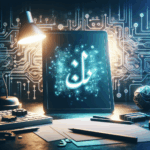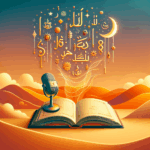Arabic Alphabet: A Tool for Understanding Arab Identity
When we think of language, we often focus on the words we speak. But what about the letters that form those words? The Arabic alphabet is not just a collection of symbols; it’s a gateway to understanding the rich and diverse Arab identity. Let’s embark on a journey to explore how these beautiful letters do more than just form words—they tell stories, preserve history, and unite millions. 🌟
Table of Contents
1. The Roots of the Arabic Alphabet
2. Arabic Alphabet and Cultural Identity
3. The Alphabet’s Role in Modern Arab Society
4. Learning Arabic: A Gateway to Arab Culture
5. Conclusion
6. FAQs
The Roots of the Arabic Alphabet 🌿
The Arabic alphabet has a fascinating history that dates back to the 4th century CE. It evolved from the Nabataean script, which was used in the Arabian Peninsula. The alphabet consists of 28 letters, and unlike the Latin alphabet, it is written from right to left. Each letter has up to four forms depending on its position in a word, adding a layer of complexity and beauty to the script.
This ancient script has stood the test of time, preserving the linguistic heritage of the Arabs and serving as a foundation for other scripts in the Islamic world, such as Persian and Urdu. Understanding the roots of the Arabic alphabet gives us insight into how language shapes cultural and historical identity.
Arabic Alphabet and Cultural Identity 🎨
The Arabic alphabet is a powerful symbol of Arab cultural identity. Calligraphy, the art of beautiful writing, is revered in Arab culture and is often used to decorate mosques, manuscripts, and public spaces. This artistic expression transforms the simple act of writing into a celebration of cultural and religious identity.
Moreover, the Arabic script has been a vessel for preserving Arab literature, poetry, and religious texts through the ages. It connects modern Arabs to their ancestors, fostering a sense of unity and continuity.
The Alphabet’s Role in Modern Arab Society 🌍
In today’s world, the Arabic alphabet continues to play a vital role in the daily lives of Arabs. It’s used in media, education, and technology, bridging the gap between traditional and modern practices. The digital era has seen the adaptation of the Arabic script into new platforms, ensuring it remains relevant and at the forefront of Arab identity.
Arabic is one of the most spoken languages globally, and its alphabet is a key component in the socio-political landscape of the Arab world. It acts as a unifying force among diverse Arab nations, each with its own dialects and cultures.
Learning Arabic: A Gateway to Arab Culture 📚
For those interested in delving deeper into Arab culture, learning the Arabic alphabet is the perfect starting point. Not only does it open the door to understanding the language, but it also provides a deeper appreciation for the nuances of Arab art, literature, and history.
There are many resources available for learning Arabic, from online courses and apps to community classes. Embracing the challenge of learning this script can be incredibly rewarding, offering a new perspective on the world and a closer connection to the rich tapestry of Arab culture.
Conclusion
The Arabic alphabet is more than just a means of communication—it’s a cultural pillar that supports the identity of millions. Whether you’re an Arab looking to connect with your heritage or someone interested in exploring new cultures, understanding this beautiful script is a journey worth taking. It offers insights into history, art, and the shared human experience. 🌍✍️
FAQs
Q1: Why is the Arabic alphabet written from right to left?
A: The right-to-left writing direction is a characteristic of several ancient scripts, including Arabic. It is believed to have originated from the way the script was originally inscribed on stone and clay tablets.
Q2: How many people use the Arabic alphabet today?
A: The Arabic alphabet is used by over 420 million people worldwide, primarily in the Arab world, but also by speakers of Persian, Urdu, and other languages.
Q3: Is learning the Arabic alphabet difficult?
A: While it can be challenging due to its unique script and pronunciation, many find learning the Arabic alphabet to be a rewarding experience. With dedication and the right resources, it is entirely achievable.
Q4: Can I learn Arabic online?
A: Absolutely! There are numerous online platforms and apps designed to help beginners learn the Arabic language and script effectively.






